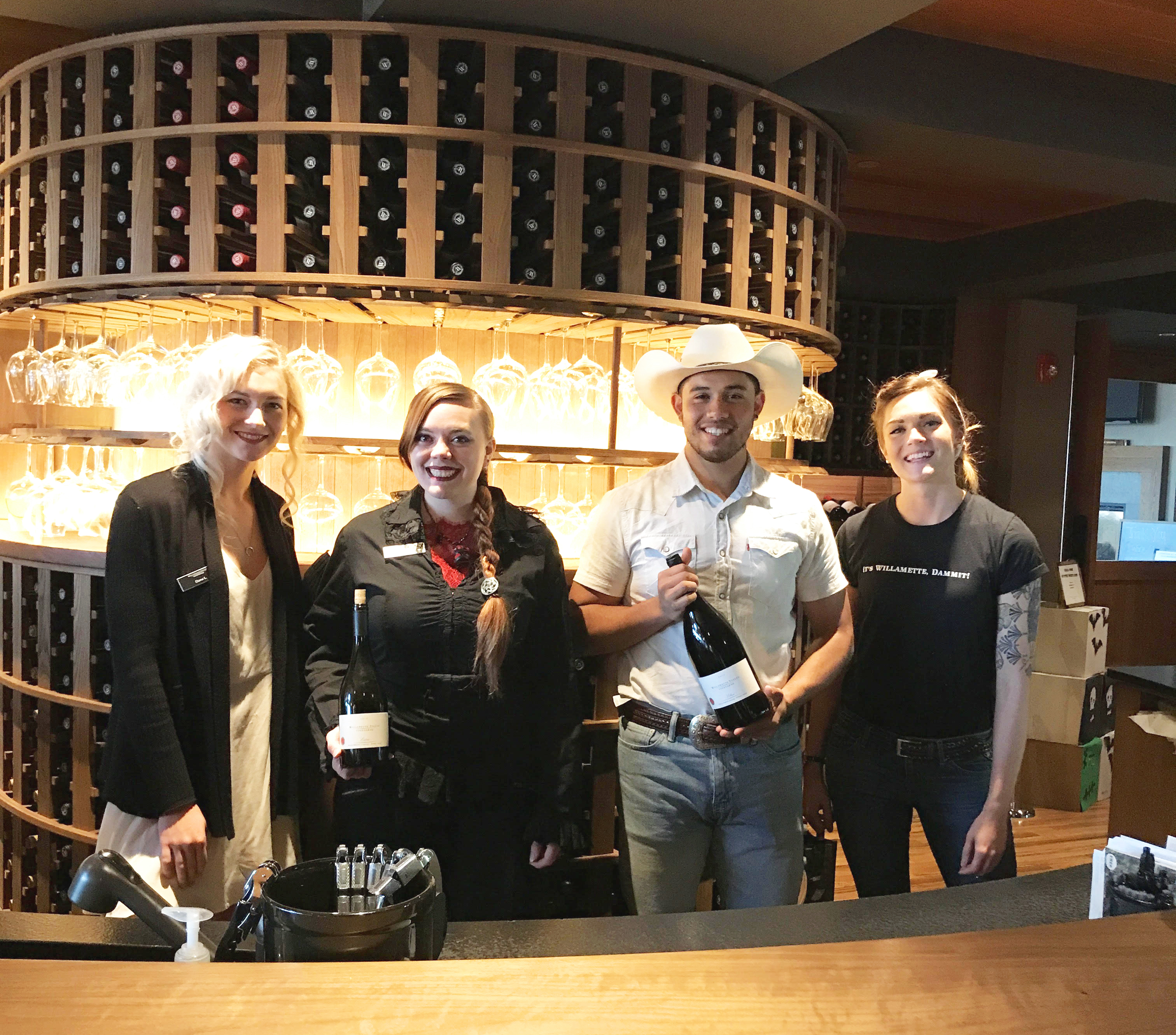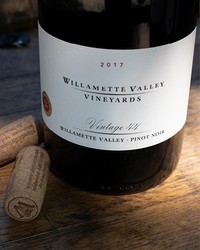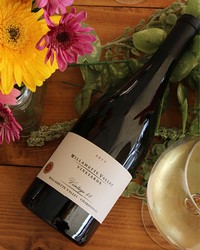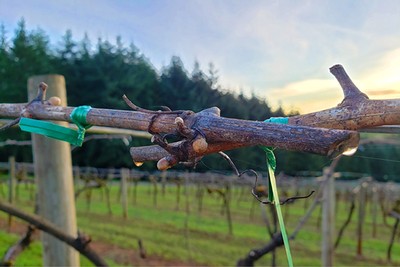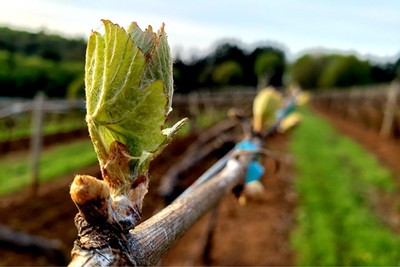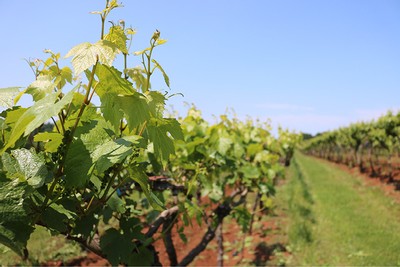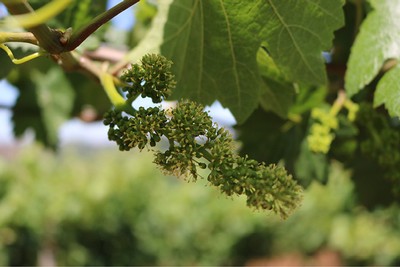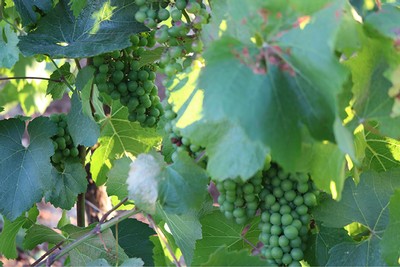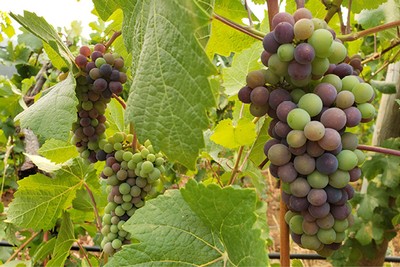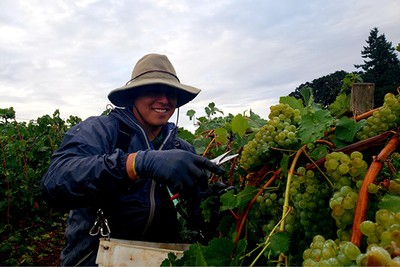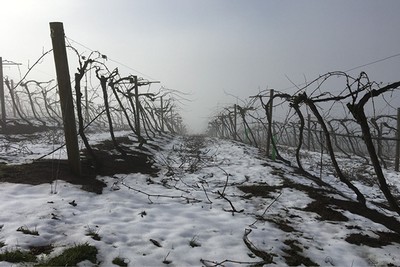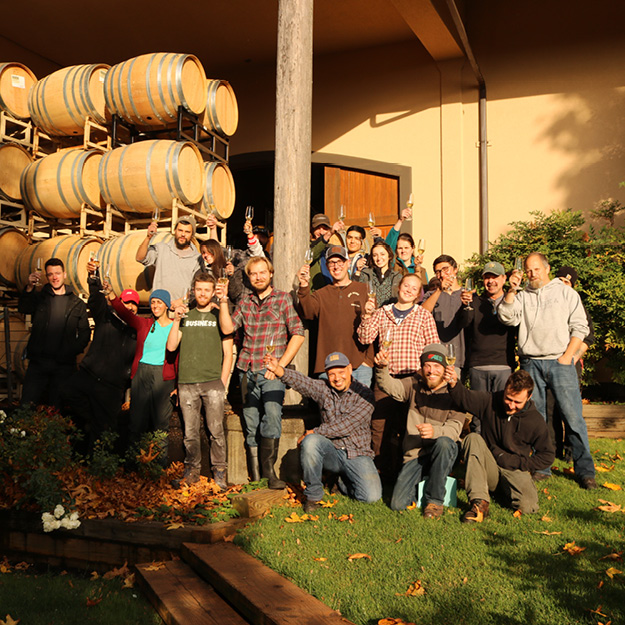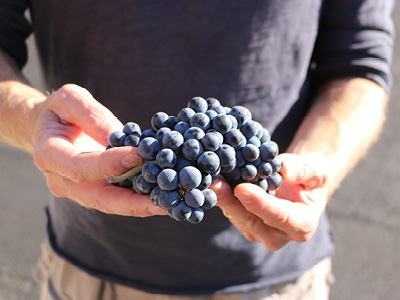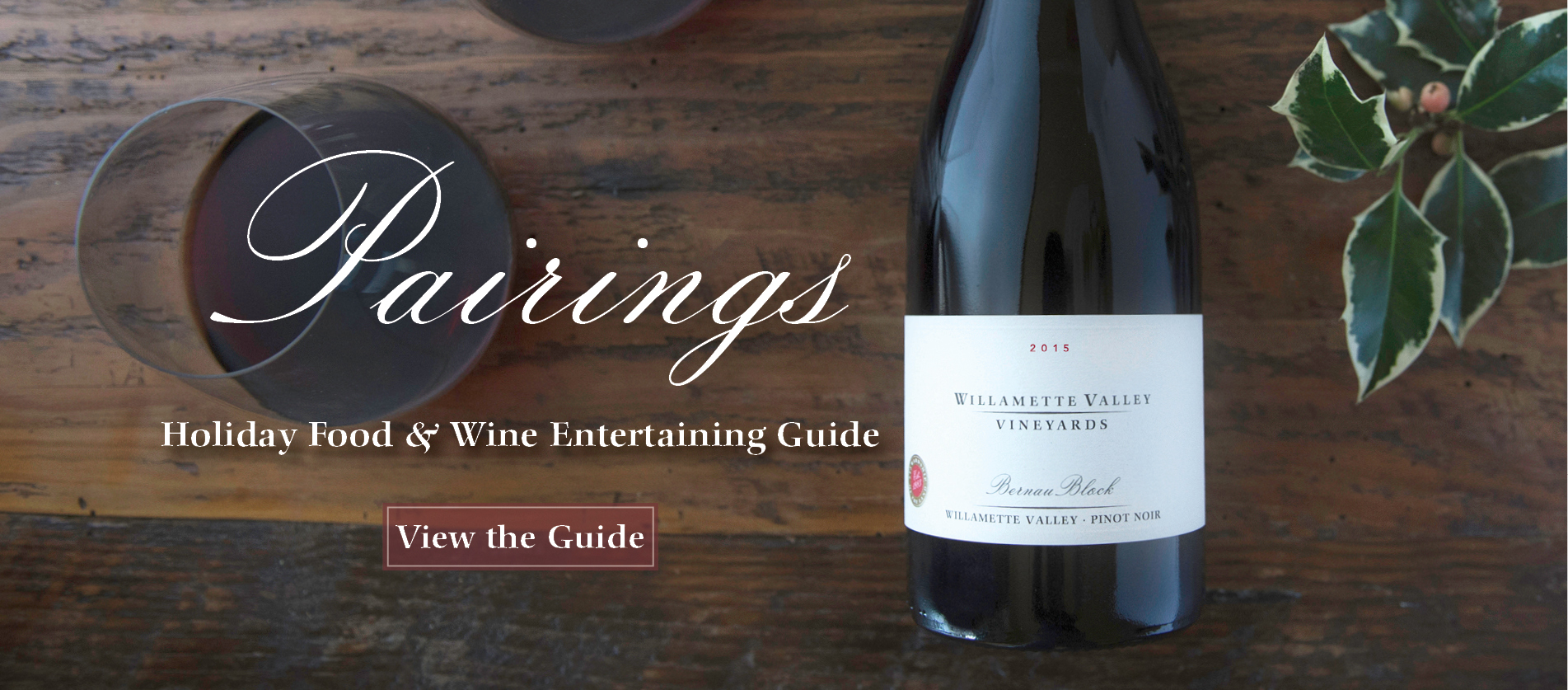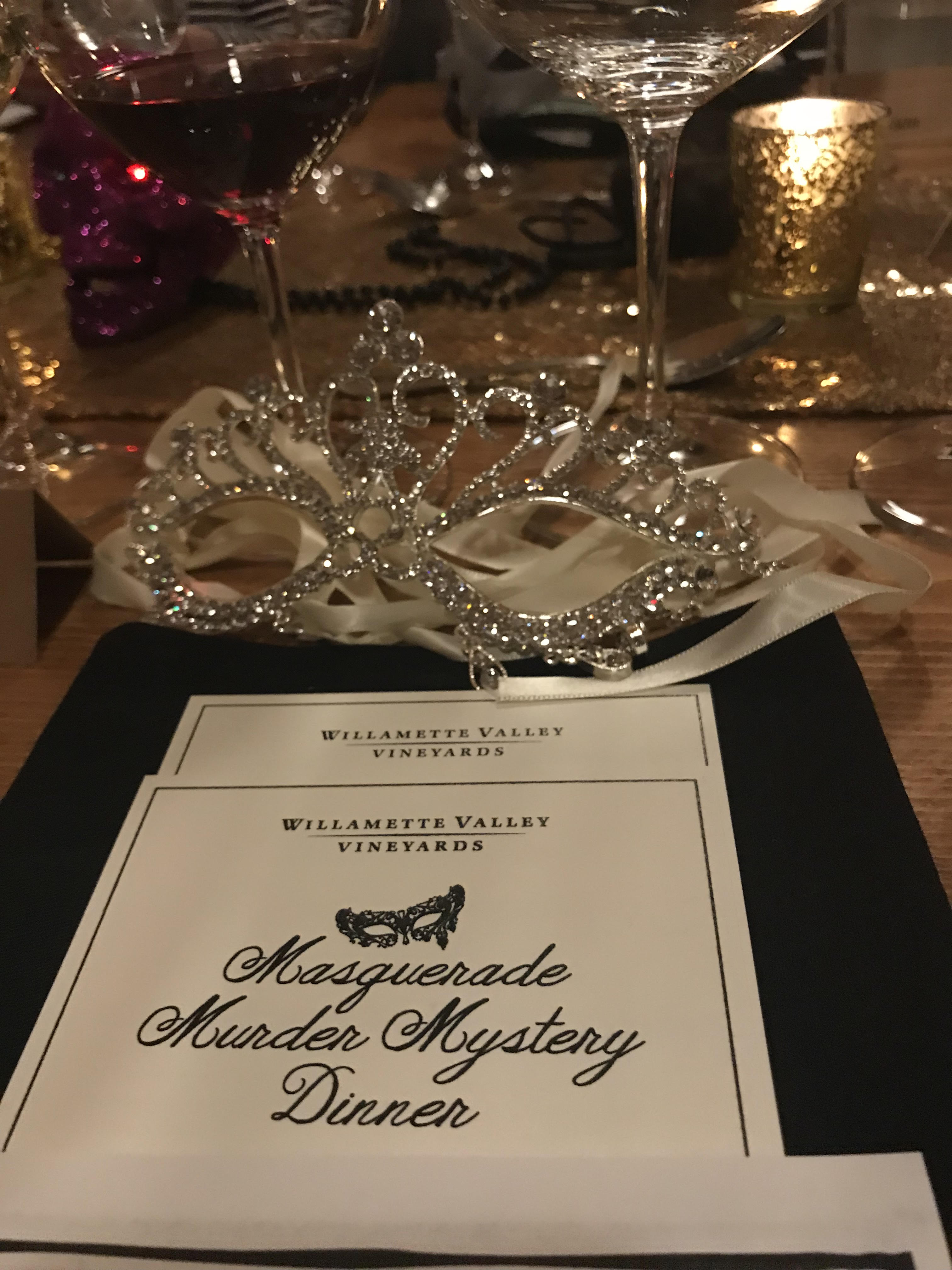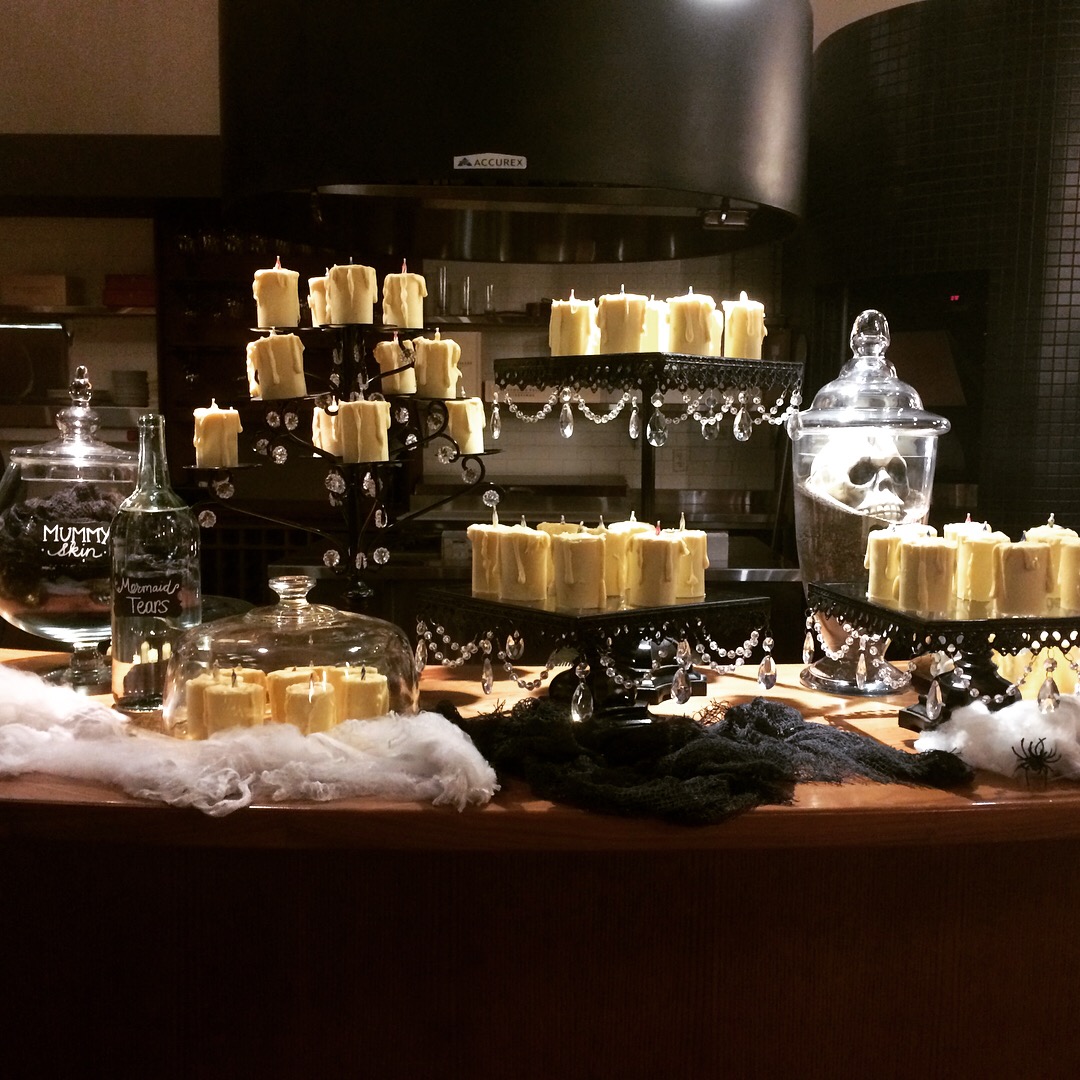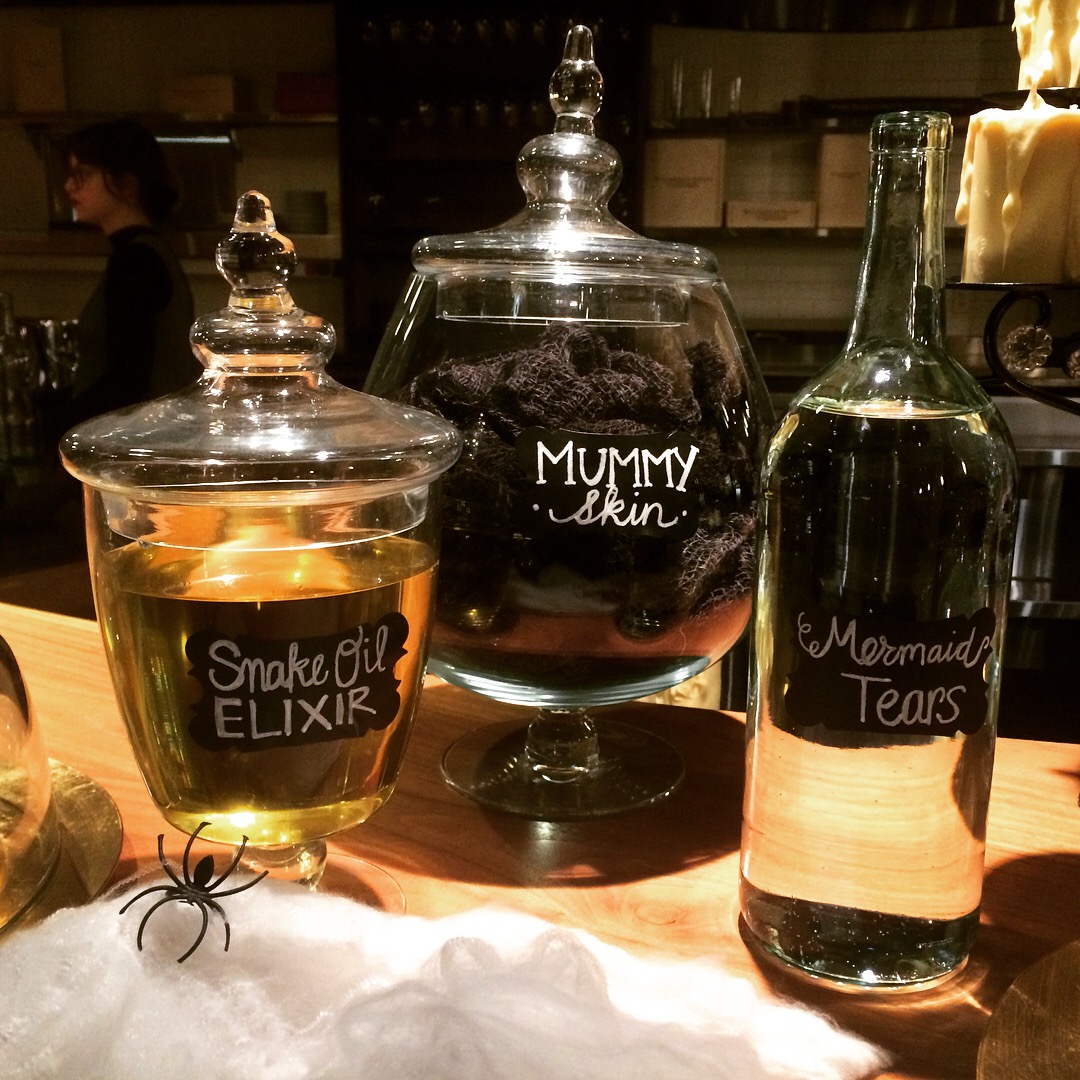Wine Pioneer Bill Fuller Makes Vintage 44 Wines at the Age 82
A passion for wine led Bill Fuller, Founder of Tualatin Estate Vineyard, to achieve a successful career in winemaking and by doing so, carved a path in the Oregon wine industry for other aspiring vintners. Continuing to inspire us, Bill is still making wine at age 82.
Bill’s Story
In 1971, Bill Fuller began exploring sites in the Willamette Valley and eventually moved from California to Oregon with his family to pursue his dreams of starting his own vineyard and producing cool-climate Pinot Noir from the Willamette Valley. As one of Oregon’s original winemakers, Bill planted the Tualatin Estate Vineyard in 1973 in Forest Grove, Oregon. The name “Tualatin” originates from the local indigenous people and means “gentle and easy flowing” referring to the Tualatin River that flows near Forest Grove.
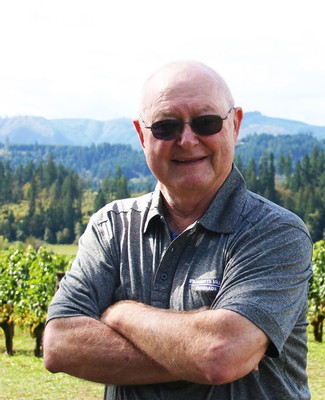
Many Firsts in the Industry
Bill Fuller’s Chardonnay and Pinot Noir both took home the “Best of Show” for the “Red” and “White” categories in the same year at the London International Wine Fair, a first-ever occurrence in the wine fair. His 1989 Chardonnay was the first Oregon wine to be named on the Wine Spectator Top 100 list.
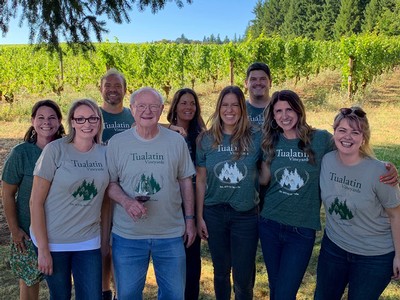
Creating our Vintage 44 Wines
Bill Fuller retired in 1997 after merging Tualatin Estate Vineyard with Willamette Valley Vineyards. Sixteen years later, Winery Director Christine Clair asked if Bill would come out of retirement as a Consulting Winemaker to assist in the making of wines produced from Tualatin Estate fruit. Bill agreed and rejoined the winemaking team to create the Vintage Pinot Noir and Chardonnay that expresses the classic techniques of his winemaking.
This August, we released the Vintage 44 Pinot Noir and Chardonnay made by Bill Fuller with a sold-out celebration at Tualatin Estate Vineyard. Bill shared some of his many winemaking stories and signed bottles for guests.
2017 Vintage 44 Pinot Noir
Ruby in color, the wine opens with aromas of ripe red cherries, raspberries, cedar and violets. Medium-bodied, silky textured with bright acidity that carries fresh red fruits, florals, earth and wood spice notes into the palate. The finish is long-lived with integrated tannins.
2017 Vintage 44 Chardonnay
Light gold in color, the wine opens with aromas of lemon, toasted pineapple, pine and spice. Rich and supple in texture, flavors of golden apple, vanilla, brown sugar and brioche lift from the palate and flow into a lingering, round finish.
Summer Wine and Fun
Summertime in Oregon is the perfect time to get outside, gather with friends and explore our beautiful state. We took a moment to ask some of our Winery employees about their favorite summer activity, and of course, favorite summer wine. We hope you enjoy hearing from our staff and get some inspiration for your next summer activity!
Joe, Head Winemaker
Favorite Summer Activity: Cooking on his smoker
Favorite Summer Wine: Estate Rosé of Pinot Noir
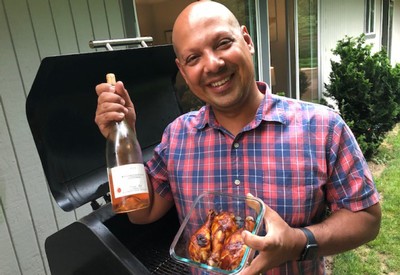
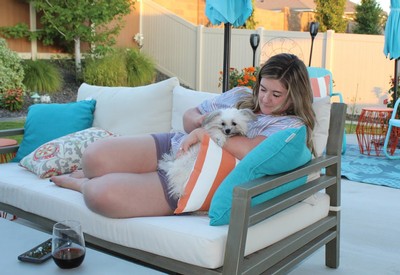
Tayler, Wine Club & Ownership Manager
Favorite Summer Activity: Relaxing outside with her dogs
Favorite Summer Wine: Bernau Block Pinot Noir
Cora, Tasting Room Associate
Favorite Summer Activity: Floating the river
Favorite Summer Wine: Pinot Blanc


Julia, Hospitality Coordinator
Favorite Summer Activity: Hiking at the coast
Favorite Summer Wine: Dijon Clone Chardonnay
Rich, Chief Financial Officer
Favorite Summer Activity: Camping on the Breitenbush River
Favorite Summer Wine: Pinot Gris
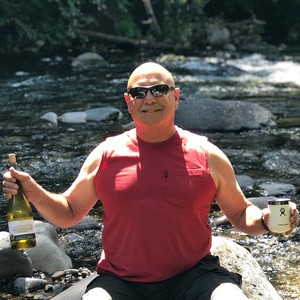

Kara, Wine Club Assistant
Favorite Summer Activity: Participating in local runs and 5Ks
Favorite Summer Wine: Pinot Blanc
Jose, Winery Ambassador
Favorite Summer Activity: Playing Sunday soccer
Favorite Summer Wine: Méthode Champenoise Brut


Spence, Estate General Manager
Favorite Summer Activity: Golfing
Favorite Summer Wine: Estate Rosé of Pinot Noir
Betty, Tasting Room Associate
Favorite Summer Activity: Trips to the Oregon Coast
Favorite Summer Wine: Tualatin Estate Pinot Noir
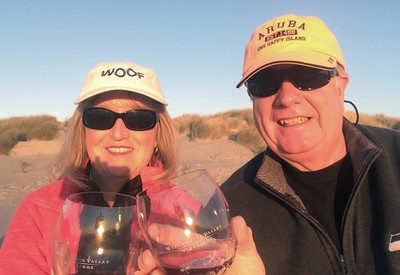
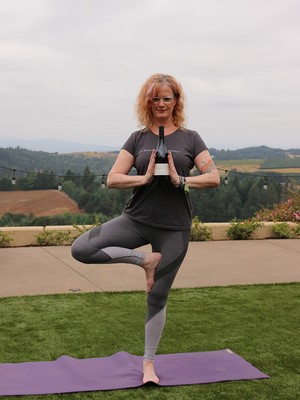
Suzanne, Winery Ambassador
Favorite Summer Activity: Teaching Saturday yoga at the vineyard
Favorite Summer Wine: Pinot Blanc
Stages in the Vines
Spring and summer are exciting times in the vineyard. The vines come back to life from their winter sleep, becoming lush and brilliant green as the temperature warms and the clusters develop into beautiful wine grapes. Each step in the growing process (detailed below) is important to the development of the clusters and hand-crafting quality wines.
Weeping:
As temperatures warm and the ground temperature reaches 50 degrees, stored starch in the vine turns into sugar, making sap. The sap moves through the vine and begins to escape from the open pruning cuts, creating “teardrops” of sap all along the vines. When vines begin to “weep” it is a sign that the growing process has begun (Indiana Uplands Wine Trail).
Budbreak:
Buds begin to form along the arms of the vine. These buds are small, fuzzy and brown at first, but as the temperature warms, they break open revealing a bright green shoot. Each shoot grows rapidly, making the vineyard hillsides a brilliant green color. The more leaves present on the vine soaking up the sun allows for more photosynthesis to occur, allowing the shoots to develop faster. Leaf development occurs simultaneously, leaves unfolding one by one as the shoot grows taller.
First Grooming:
Once the vines become dense with greenery, our vineyard crew will make their way through the vineyard to trim excess canes. Grooming excess canes helps regulate the amount of vegetation present on the vine. If there is too much vegetation, the nutrients from the vine are more thinly distributed, producing grapes that lack complexity and concentration of flavors. This is where the saying “quality over quantity” rings true.
Flowering:
Along with the large, wide leaves now on the vine, small clusters can be seen. Shortly thereafter, with assistance from the sun, tiny flowers spring to life on the cluster. As these flowers bloom, self-pollinate and lose their caps, small grape clusters will begin to form.
Berry Set:
Tiny green berries are now visible on the vines. The grapes are a bright green and about the size of a pencil eraser. They are also very hard and dense as they are mostly comprised of acid and short tannins. At this stage, almost all grape varietals look the same. The grapes clusters will continue to grow and develop for the next month or two.
Veraison:
Veraison is the second and most noticeable stage of grape ripening. During veraison, the grapes experience a big decrease in acid levels and a big increase in sugar levels. As they ripen, the grapes change color and our vineyard crew will once again prune the vine canopy and excess clusters to ensure the remaining clusters continue ripening well. Our winemaking team will then test the sugar level and tannin structure of the grapes to determine if the clusters are ready to be harvested.
Harvest:
Once our Winemaker decides the grapes are ready to be harvested, our expanded vineyard crews get to work. Wine grape varietals are harvested at different times depending on the type of grape, elevation at which they are grown and the style of wine being made. Grapes used for wines with brighter acidity, such as Brut or Pinot Gris, are harvested earlier when acid levels in the grapes are still high. Grapes for softer style wines, like Pinot Noir, are harvested later once acid levels in the grapes have had time to decrease and sugar levels have increased.
Dormancy:
When harvest is over, the work in the vineyards is not done. The winter months are an important part of the vineyard lifecycle too. After the vines enter a dormancy phase, our vineyard crew will carefully prune the vines to prepare for the next growing cycle. The clippings are eventually ground into mulch and recycled back to the earth. When the vines awaken in the spring, these thoughtful cuts will inspire growth in all the right places leading to better yields and increased air flow. In early spring, the vineyard team will begin tying the vine canes to our trellises to support new growth for the new vintage year. And thus completes the continual cycle in the vineyard.
Biodynamics
What is biodynamics?
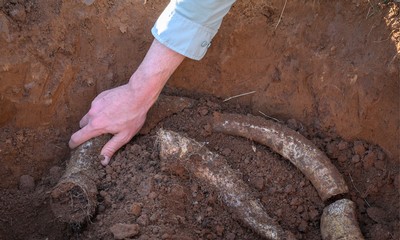 Biodynamics is a holistic, ecological and ethical way of farming used in all kinds of agriculture. It involves managing a farm utilizing the principles of a living organism. Applying biodynamics in the day-to-day operation of a farm, or in our case a vineyard, involves creating a farming system that is minimally dependent on outside materials to meet the needs of the land. Outside materials can include chemicals, pesticides and other harmful sprays. The biodiversity of the farm is organized so that the waste of one part becomes the energy for another. This results in an increase in the farm’s capacity for self-renewal and helps it become more sustainable (Demeter Association, Inc.).
Biodynamics is a holistic, ecological and ethical way of farming used in all kinds of agriculture. It involves managing a farm utilizing the principles of a living organism. Applying biodynamics in the day-to-day operation of a farm, or in our case a vineyard, involves creating a farming system that is minimally dependent on outside materials to meet the needs of the land. Outside materials can include chemicals, pesticides and other harmful sprays. The biodiversity of the farm is organized so that the waste of one part becomes the energy for another. This results in an increase in the farm’s capacity for self-renewal and helps it become more sustainable (Demeter Association, Inc.).
The process of becoming biodynamically certified takes approximately 3 years. Biodynamic certification can be done through the Demeter Association, which holds strict farm and processing standards in order to achieve certification.
How are we using biodynamic practices at Bernau Estate?
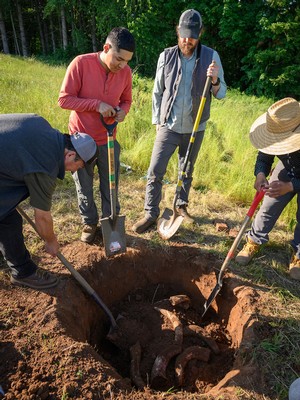 Each fall, female cow horns are stuffed with the manure from cattle native to the growing area and are buried for at least 6 months. During this time, the manure in the horns transform into a nutrient-rich preparation that is attuned to the land. In the spring, once the horns are unearthed, the preparation is enlivened with water and sprayed over the vineyard. Each horn produces enough preparation to cover 1 acre of land with multiple sprays throughout the growing season. Biodynamic Preparation 500 has shown to accelerate and improve the soil structure, microbiological activity, while enhancing a sense of place.
Each fall, female cow horns are stuffed with the manure from cattle native to the growing area and are buried for at least 6 months. During this time, the manure in the horns transform into a nutrient-rich preparation that is attuned to the land. In the spring, once the horns are unearthed, the preparation is enlivened with water and sprayed over the vineyard. Each horn produces enough preparation to cover 1 acre of land with multiple sprays throughout the growing season. Biodynamic Preparation 500 has shown to accelerate and improve the soil structure, microbiological activity, while enhancing a sense of place.
Viticulturist Clay Wesson, who is currently leading our biodynamic practices, used new plantings at our Bernau Estate as an opportunity to trial several different applications of biochar and biodynamic compost. Biochar is a plant-based charcoal used as a soil amendment and is known to offer a number of benefits for soil health. Many of these benefits are related to the extremely porous nature of biochar, including retention of both water and water-soluble nutrients, while aiding in the creation of habitat for many beneficial soil microorganisms.
We are currently striving to make the vineyard at our new Bernau Estate 100% biodynamic.
2018 Vintage Update
Our team took a few minutes to check in with our Head Winemaker, Joe Ibrahim, to get his opinion on our recent 2018 harvest and get an idea of what to expect with our 2018 vintage.
How was the 2018 harvest?
The 2018 Harvest was amazing! The growing season was warm and dry and that continued into the harvest season. Winemakers had their choice of pick days without the fear of seasonal rains, which allowed us to achieve the exact level of ripeness we wanted from the grapes.
How do the wines look?
The wines look fantastic! Each time we taste these wines we are so excited. The red wines are rich and dark in color with moderate alcohol levels. The early signs of complexity are starting to show in the completed lots and will continue to become more nuanced through the aging process. The white wine wines are bright and fresh and show a nice balance of fresh fruit with hints of tropical fruit, and good body weight.
What can we expect from this vintage?
Along with us, other Oregon wine producers also experienced an outstanding vintage. I think its safe to say that we will be seeing some great write ups on the 2018 vintage wines. 2018 will likely be known as one of Oregon’s best and will be argued to be the very best vintage. This will benefit not just us, but the industry as a whole as we continue to tell the story of quality wines coming out of Oregon.
Are there any stand-out wines you are excited about?
Its still early, but there are exceptional lots from all our estate properties. It was fun to get to know the new vineyard blocks from the Bernau Estate Vineyard and those wines look to be very strong. Bernau block Pinot Noir from our main estate and the new century blocks from Elton, as well as Peter Micheal, and Meadow View sections from Tualatin Estate are some of our top lots.
Jim Bernau Responds to Copper Cane's Joe Wagner
The Oregonian article regarding Copper Cane's misrepresentation of Oregon AVAs on its labels and marketing materials generated a lot of interest, as did the Oregon Wine Press article "Joe Wagner Responds: Copper Cane owner explains his side of the story."
In the latter, Wagner made a number of claims about his dispute with the Oregon Winegrowers Association and our founder/CEO Jim Bernau.
Jim Bernau responded in this Q&A on Wine Business Monthly and has since added some additional information:
Why is the Oregon Winegrowers Association challenging Elouan and “The Willametter” marketing?
JB: The marketing is deceptive, violating federal and state law. For example, printed prominently on the Elouan case boxes is “Oregon Coast Pinot Noir,” appearing to play off prominent California Coast AVAs. No Pinot Noir is grown on the Oregon Coast (or successfully can be). Three leading Oregon AVAs, the Willamette Valley, Umpqua Valley and Rogue Valley are listed as if they are nested in this larger, fictitious AVA.
The branding on “The Willametter Journal” and a number of Elouan labels, packaging and marketing materials illegally state or deceptively infer Oregon AVAs. This branding has created market confusion and is devaluing our distinctive AVAs. Consumers are being led to believe these wines are made in Oregon, they are not.
Federally approved American Viticultural Area designations are based upon unique geology, soils and climate taking much research and a lengthy process to obtain from the federal agency, the TTB. They are especially so in Oregon as their use or inference on labels and marketing materials require strict adherence to the highest AVA and variety standards in the nation.
The wine must be made in Oregon with 100% Oregon grapes, only one AVA may be stated or implied with the grapes being a minimum 95% from the named AVA and at least 90% Pinot Noir (and other varieties) when those varieties are named.
Oregon winemakers have worked together for 35 years adhering to these standards and paying the highest tonnage tax in the country to support them.
On Standards of AVA content:
JB: Joe Wagner’s actions threaten the AVA system of unique geographic pedigrees federally adopted in 1978 with now 242 distinct AVAs in the United States.
He is illegally listing AVAs, allowing him to capitalize on the reputation they have achieved. Wagner now is advocating he be allowed to list percentages of grape content from the named AVAs, but this approach would gut the unique, individual distinctiveness of each AVA.
Isn’t this what he did with Meiomi?
JB: No, the Meiomi label relies on a provision in the federal code allowing up to three counties to be listed with percentages. As these California counties are well known, the marketing worked. While the Oregon counties Marion, Josephine and Jackson can be used to market Elouan, they are not well known. Joe Wagner is instead using something to which he is not entitled — Oregon AVA names which are based upon specific viticultural conditions and winemaking standards that are highly regarded by consumers.
Haven’t other wine regions including the Napa Valley seen this kind of behavior?
JB: The Napa Valley Vintners Association has been very active in stopping deceptive advertising of wines capitalizing on the equity winegrowers have built over the years in that AVA. Richard Mendelson wrote “Appellation Napa Valley, Building and Protecting an American Treasure” detailing the many attempts to deceptively exploit the financial premium that has been created in the marketplace for the remarkable wines of the Napa Valley AVA. The Wine Origins Alliance (Origins.wine), dedicated to protecting the integrity of wine region names, recently secured passage of U.S. Senate Resolution 649 recognizing the value of AVAs.
On Wagner’s claim of better winemaking control in California:
JB: Wagner is reported to say he likes “to do everything under one roof,” giving him the winemaking control he wants. That it is cold comfort regarding adherence to Oregon standards and doesn’t square with his federal label (COLA) filings.
Elouan is made at LangeTwins, a contract 4 million case plant near Lodi, the same who makes Meiomi. That’s an hour and half drive from Rutherford where The Willametter is made. Wagner has used three custom crush plants (including Safe Harbor Partners and Laird Family Estate) and two Copper Cane facilities in different locations for his Oregon labeled wines. For example, there are two COLAs for the ‘16 Elouan Pinot Noir at Laird Family Estate in Napa & Copper Cane in Rutherford in the same year.
While we know he isn’t following the law on labeling and advertising, we hope the cellar staffs of these numerous plants know the difference between Oregon and California standards and are following Oregon law — although his wines don’t taste like Pinot Noir from the Willamette Valley.
For example, it is illegal in Oregon labeled wine to use additives commonly used to make mass produced Pinot Noir in California. Color and mouthfeel concentrates called Mega Purple, Ultra Red, Purple 8000 and Red 8000 are made from the Teinturier grape Rubired which is prohibited in Oregon wine since the grape is not grown here. Illegal use of even a small amount of these powerful additives greatly alters the distinctive, cool climate Willamette Valley Pinot Noir colors, aromas and flavors.
The Oregon Congressional Delegation has requested the TTB conduct field product integrity audits of Copper Cane asking “any offending products should be removed from the marketplace immediately.” The TTB is very thorough, reconciling grape contracts, grape sources and varietal composition, weigh tags, winery computer recorded additives identified in the Varietal Composition or Ingredient fields, cellar work orders, ingredient POs and invoices, tank and barrel transfers and finished packaged volumes compared to the label, packaging and advertising claims.
Aren’t some of the industry’s complaints about federally approved labels?
JB: The TTB label reviewers were misled. Wagner used the term “Vinted” instead of using the legally required term “Produced” on the label. He was actually producing the wine from grapes in California.
A label reference to an AVA is legal if the wine is “Produced” (fully finished) in the state of origin. By using the term “Vinted” on the label, the TTB was misled into believing the wine was made from grapes into wine in Oregon then trucked as bulk wine to California for bottling. If Wagner had used the term “Produced” on the label, as he is required to do, the TTB would have caught it and rejected the label submissions. The term “Vinted” is allowed when the wine is subject to cellar treatment at the bottling address.
The TTB does not see the case box design or the sales materials but requires that those representations be accurate and consistent with their label approval. They depend upon consumer and trade monitoring and act upon complaints which is what they are doing now. What appears to be misdirection on the label application and then the use of Oregon AVAs on packaging and sales material with a retail bottle price under $20 has resulted in a commercially very successful result. Neilsen 12-month scan data shows that Elouan Pinot Noir has grown into the number one selling Oregon branded Pinot Noir above $17 a bottle in just a few years — a wine that is advertised originating from the Oregon Coast and now made near Lodi, California.
As for the reference of multiple AVAs on the approved ‘17 Elouan Pinot Noir, we believe the TTB label reviewer just missed it. Only one reference is allowed under federal law, 85% of the content must be from the referenced AVA with the wine made in the state of origin. The Oregon wine industry has asked the TTB to withdraw approval of this label to preserve the AVA system and truth in labeling — AVAs are not blending grapes, they are distinctive geographic designations representing the wine from that specific AVA.
What’s the financial benefit to using Oregon AVAs?
JB: If Wagner was making and selling his wine legally like other Oregon producers sourcing from various AVAs, he would only be able to list “Oregon” as the origin. But wines using an Oregon AVA, like the Willamette Valley, earn a higher price (costs are higher too). One can make more money by using lower cost grapes, mixing in some higher cost Willamette Valley AVA fruit and deceptively marketing it by referencing the Willamette Valley.
Among the top 25 Oregon Pinot Noir brands reported by volume in annual Nielsen scans, the average retail bottle price is $26.04 for Willamette Valley AVA Pinot Noir, but $14.30 for a Oregon appellated Pinot Noir. Elouan, with its Willamette Valley packaging, has put the AVA on discount at $7 per bottle less at the attractive under $20 retail price — helping explain its sales growth.
For every 100,000 cases of sales, Elouan Pinot Noir marketed with the Willamette Valley AVA can illegally achieve approx. $3 million more at FOB than the average “Oregon” appellated wine.
What’s this claim about Wagner not paying his Oregon taxes?
JB: Wineries licensed to make wine in Oregon must pay $25 per ton tax to support the wine quality and marketing efforts of the state and AVAs. As one must make the wine in Oregon to legally use the state’s AVAs, Wagner is dodging the tax, but still using the AVAs. If he had made the wine in Oregon, an estimated $200,000 in taxes would have been properly paid.
Why are Southern Oregon growers so unhappy with Copper Cane?
JB: Wagner, using a smoke taint clause, cancelled all his Rogue Valley grower 2018 picks (130,000 case equivalent) only days before harvest, leaving growers no time to find alternative buyers.
Nielsen retail annual data ending in June shows Elouan scanned 45,146 cases in national retail sales, an annual growth of 19,730 cases. For grocery store brands, Nielsen scan data can account for more than 70% of total sales. Copper Cane reported to the Oregon Liquor Control Commission purchasing 4,026 tons of Oregon grapes in 2017, equivalent to approx. 261,715 cases. Elouan ‘15 Pinot Noir on the shelves in Oregon is behind a vintage and a major chain is discontinuing the ‘16 Rosè and has been seen at Grocery Outlets for $3.99 per bottle.
Doing the math, it looks like Copper Cane is severely over inventoried and to be fair to the grower families, Wagner should at least pay the uninsured growers for their crop. We do support the insurance claims of those impacted by smoke taint as we learned of pockets of damaged fruit first hand. A blanket cancellation was unfair in those instances where quality was high, casting a pall on the Rogue Valley ‘18 vintage, among the nicest grapes in decades.
A coalition of Oregon winemakers, using independent lab results, saved as much of the stranded, high quality crop as possible, paying the full contracted prices. The wine developing in the cellars is beautiful. We can’t wait to release the Oregon Solidarity wine, first envisioned by Ed King of King Estate Winery, as a fundraiser for the devastated growers.
Why do you think Wagner has filed to cancel your trademarks?
JB: We believe he is trying to bully us. Shortly after I asked Wagner to stop misrepresenting Oregon AVAs and infringing on our trademarks, his lawyers filed to cancel them. A tactic like that might work with someone who doesn’t have the money or the community support to defend themselves.
He has signaled he will drop the trademark challenge and the Willametter brand if we support Elouan with his use of the state’s AVAs listing percentages of content. In his effort to profit from the equity others have built, this proposal would destroy the AVA system. We believe in the value of these geographic pedigrees and the reputational equity winemakers and growers have created in them.
There is some irony in his argument, that our winery brand should lose its trademark due to the AVA having the same name, given his illegal use of it.
We will oppose his trademark cancellation attempts for the same reason we will defend our AVAs, not just for ourselves, but the many other wineries with brands similar to or the same as AVAs. Just because an AVA is established, it doesn’t mean the winery trademark is no longer valid. The “discovery” process in the trademark proceedings may reveal what is actually in the Wagner “Oregon” and “Willametter” wines.
The Oregon wine industry has grown through collaboration and respectful treatment of its colleagues. Oregon winemakers welcome newcomers with kindness, but ask for lawful and respectful conduct in return.
What are you asking the industry leaders of the nation’s AVAs to do?
JB: We are asking they write the Administrator of the TTB and ask that in the TTB label approval process they enforce the law to preserve the integrity of American Viticultural Area destinations by allowing only one AVA to be named, referenced or implied on the label and only on wine that is legally qualified for such a reference.
Second, we are asking industry members to contact their state liquor control agencies asking that upon licensee renewal for Copper Cane to do business in their state, Copper Cane be required to demonstrate, under penalty of perjury, that they are in full compliance with all federal and state laws (including Oregon law when using those designations) regarding wine composition, labeling, packaging and advertising.
By acting in solidarity, the nation’s AVAs can protect our unique geographic designations.
View Jim Bernau's PowerPoint presentation.
Willamette Wineworks - Just the Beginning
 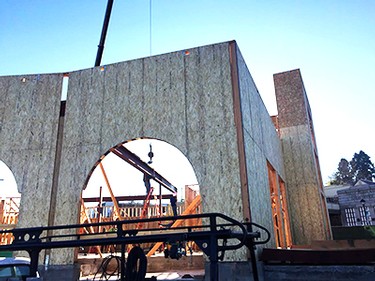 |
The Roundhouse building in Folsom, California is making beautiful progress and is the future home to Willamette Wineworks — a new food, wine and blending experience by Willamette Valley Vineyards! Located in a beautiful part of the downtown area, the Roundhouse and Willamette Wineworks are expected to finish in the fall.
As of March 20th, all the welding was completed and the interior steel was set, allowing us to move on to the second floor where Willamette Wineworks will live. By late April, we'll be ready for the roof and parapet trusses. We are delighted to watch the progress after kicking off construction with a Roof Raising Celebration on February 17th. More than 300 Owners and wine enthusiasts joined us to toast the new station and take a commemorative photo that captured the historic moment. Being in Folsom, meeting locals and seeing their eagerness for the project, has sparked an incredible enthusiasm to join this vibrant community.
When Founder Jim Bernau learned about the vision for the new Historic District, he knew this was an incredible opportunity to share our story with more wine enthusiasts in California.
"Joining my brother in his Historic Folsom Station development and connecting our family's history to the area is a lifelong dream. We look forward to sharing our wine story through this new experience and being active members of the Folsom community," Jim explained.
Willamette Wineworks will feature our classic Oregon wines and food pairings from a local favorite, Scott's Seafood. They will be relocating to join us in the new Roundhouse building modeled after the original design, which housed trains in the 1800s. The new and unique hands-on wine-blending experience will allow people to learn more about the process of winemaking and enjoy their new wine creation.
Thank you to our Founding Owners for your continued support of Willamette Valley Vineyards and our new projects. We are excited to expand into the town of Folsom and grow our community of wine enthusiasts.
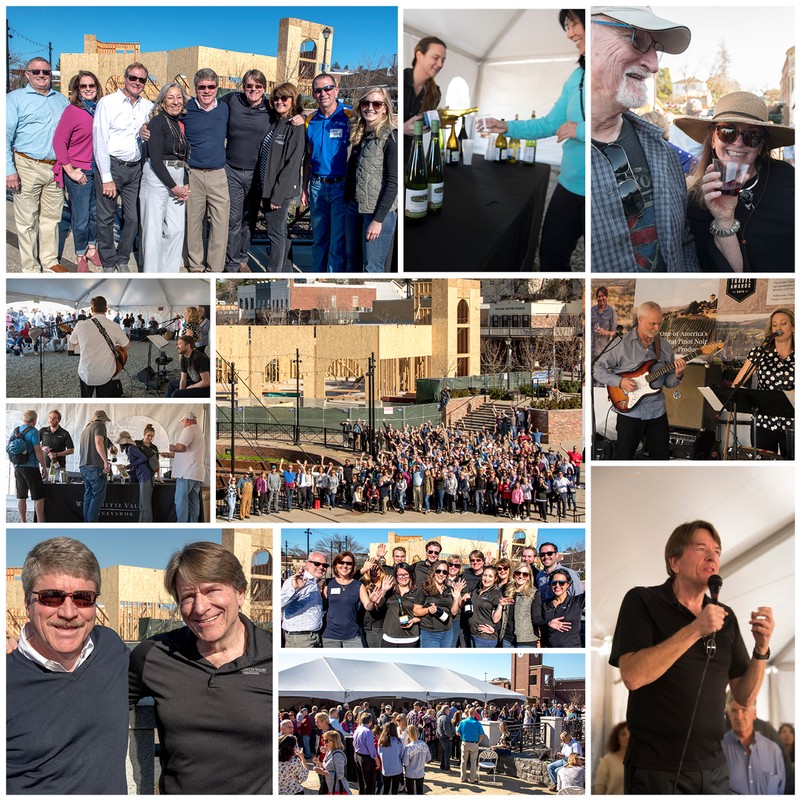
Introducing the 2017 Holiday Food & Wine Entertaining Guide!
Please enjoy our Pairings - Holiday Food & Wine Entertaining Guide, which is inspired by the food and wine pairings we feature at our Estate Tasting Room. I hope you will share the recipes with your friends and family this holiday season. Our Willamette Valley Pinot Noirs and cool-climate whites are acclaimed for being some of the most versatile food-friendly wines in the world. They enhance meals with their delicate aromas and flavors, refreshing acidity and elegant finishes.
We wanted to make it as easy as possible to order these wines for your table and to purchase as gifts. You will find special savings on wine, holiday gift sets and shipping enclosed. Call 1-800-344-9463 to have a friendly Winery Ambassador assist with your order or shop online.
New Daily Pairings Menu
We are excited to present our new Daily Pairings Menu filled with fresh, local seasonal ingredients that pair perfectly with our latest wine releases. Our Estate Tasting Room is open daily from 11 am - 6 pm. Please join us soon!
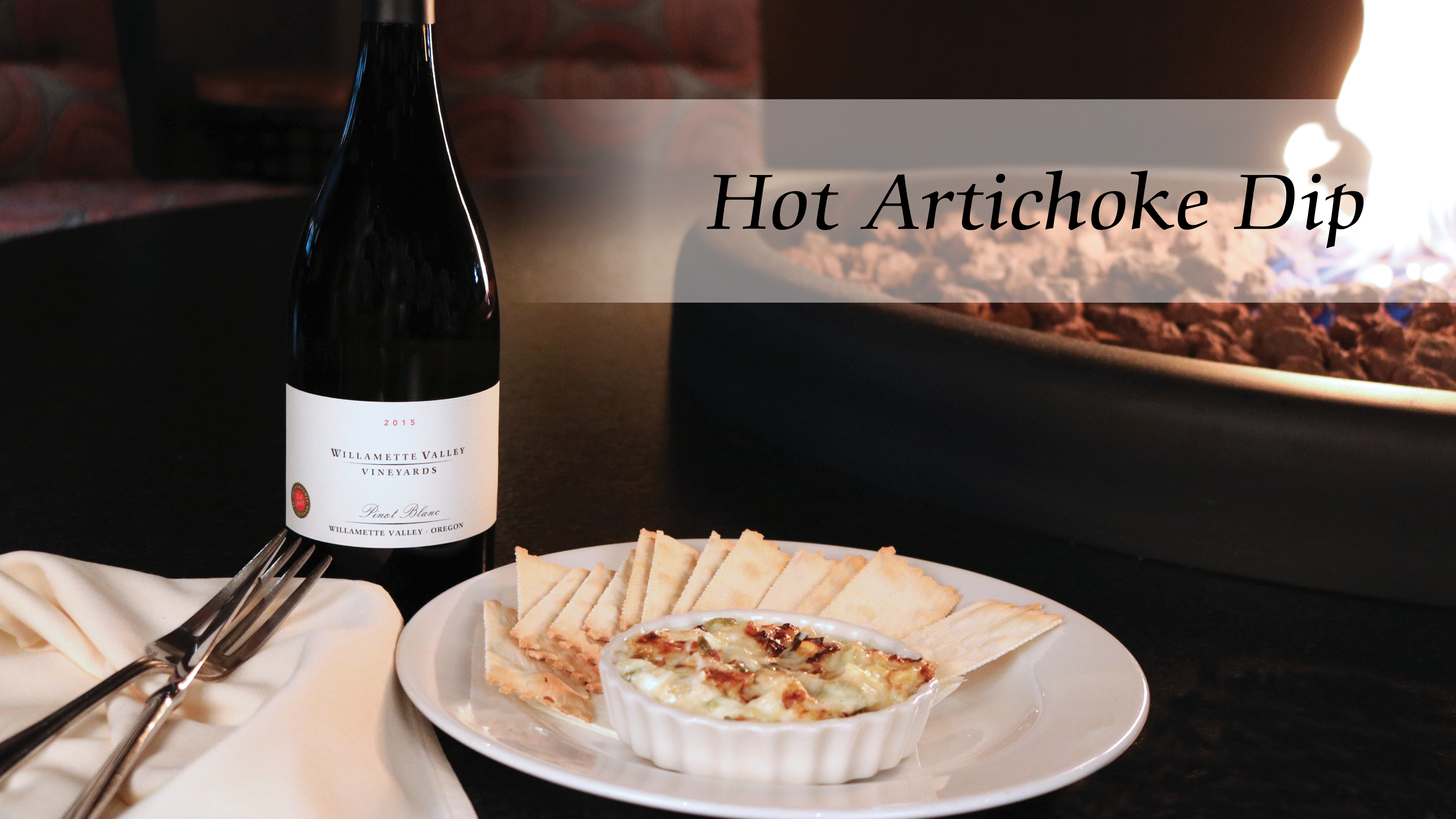
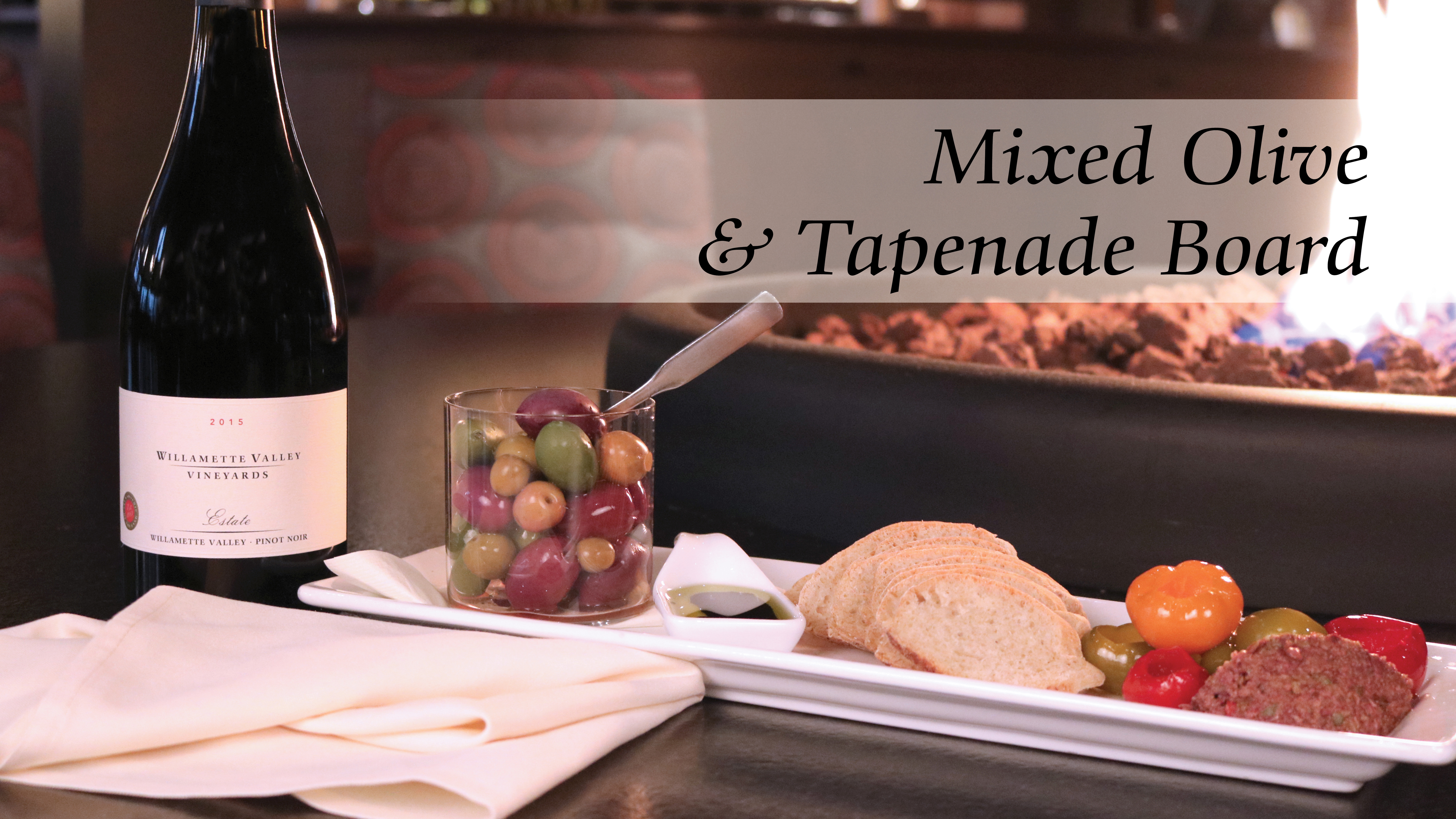
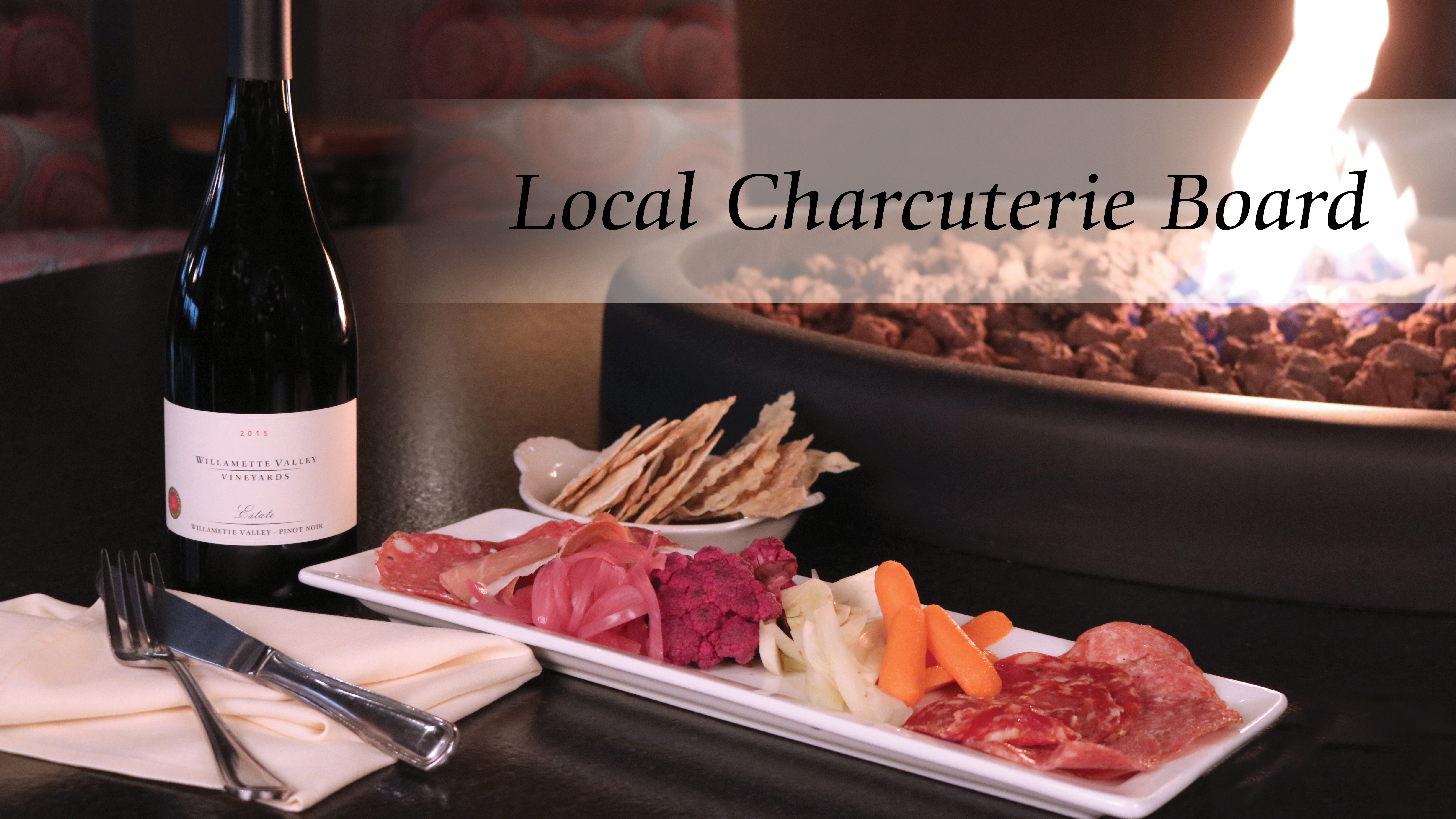
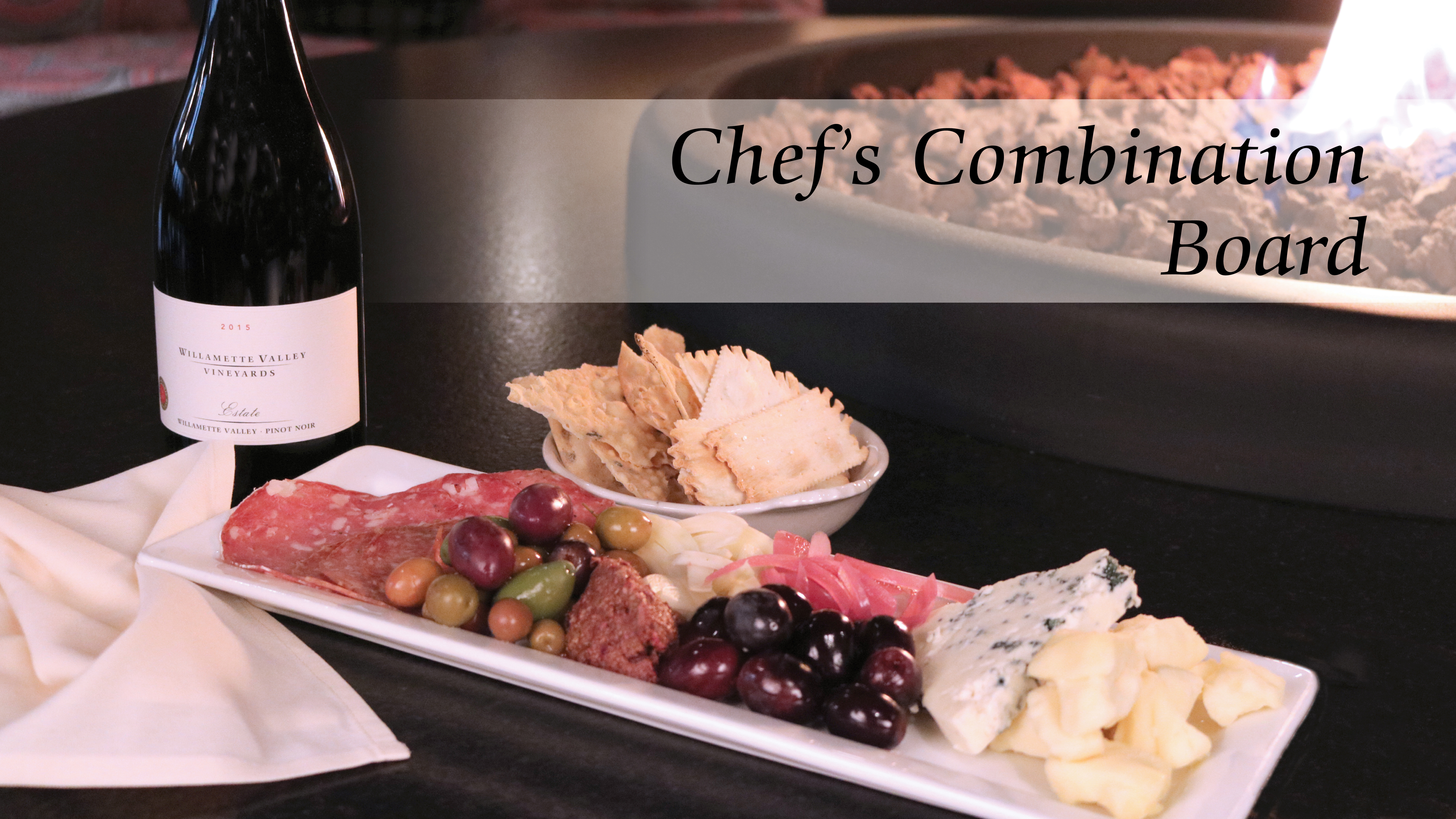
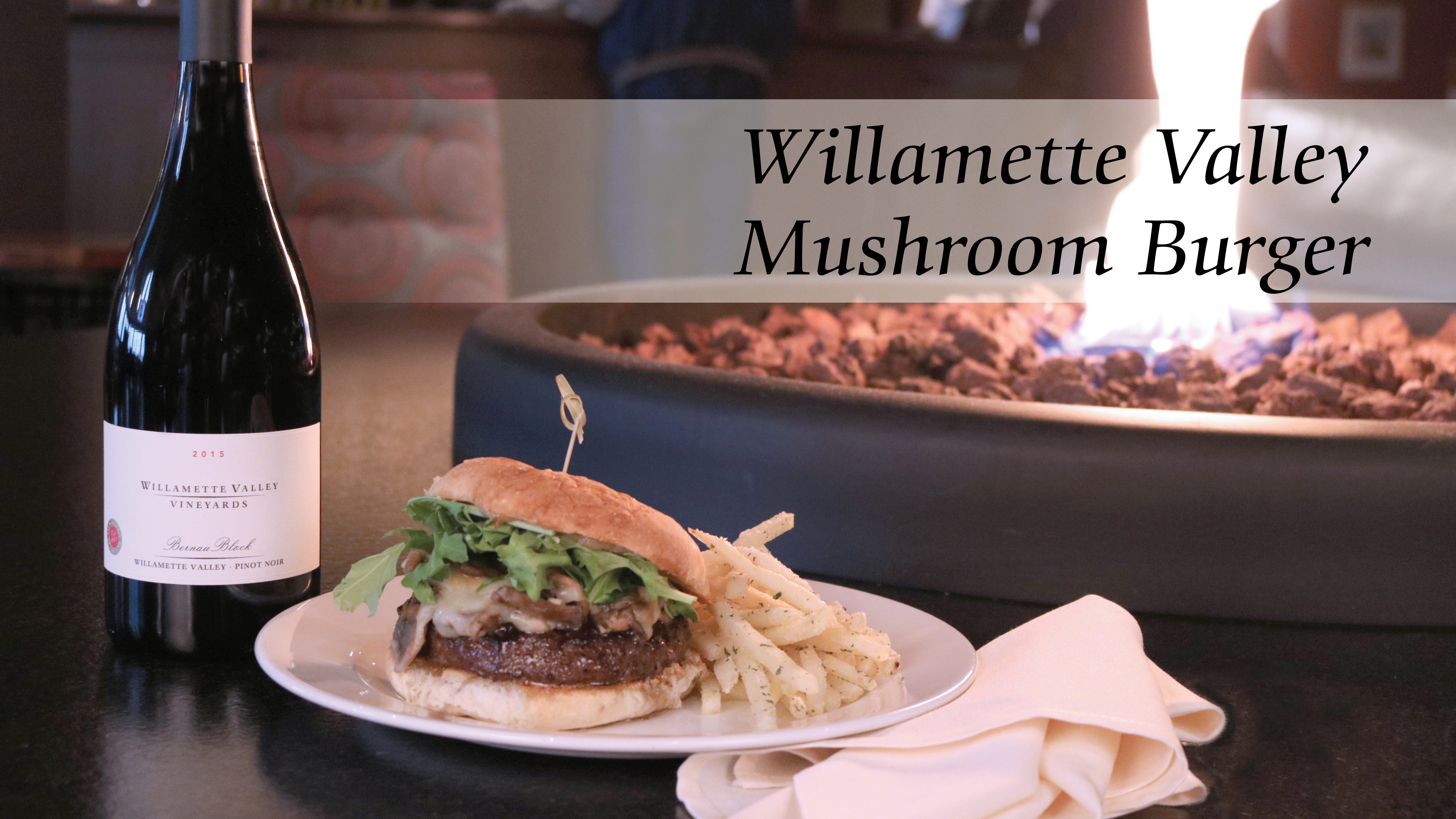
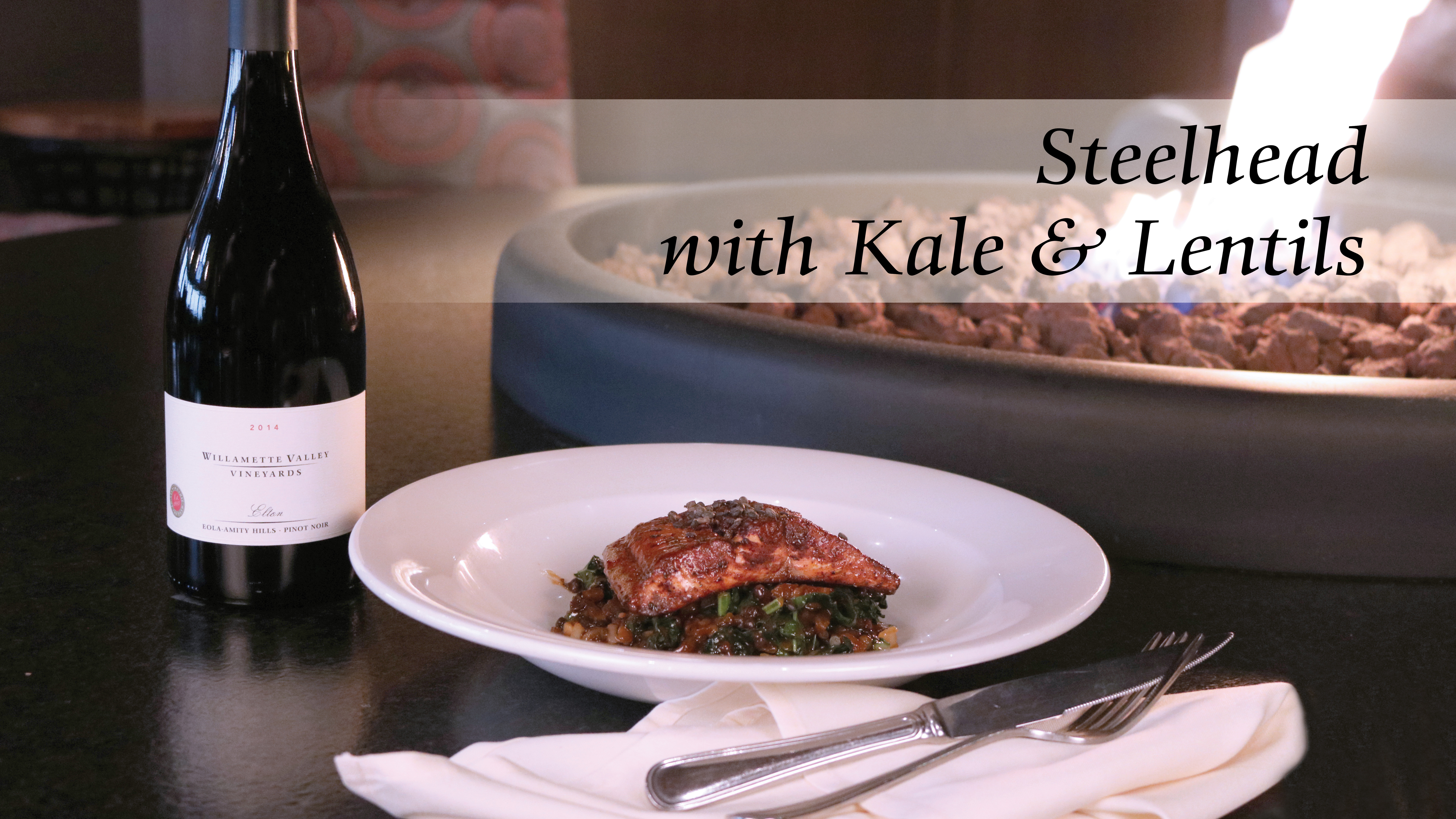
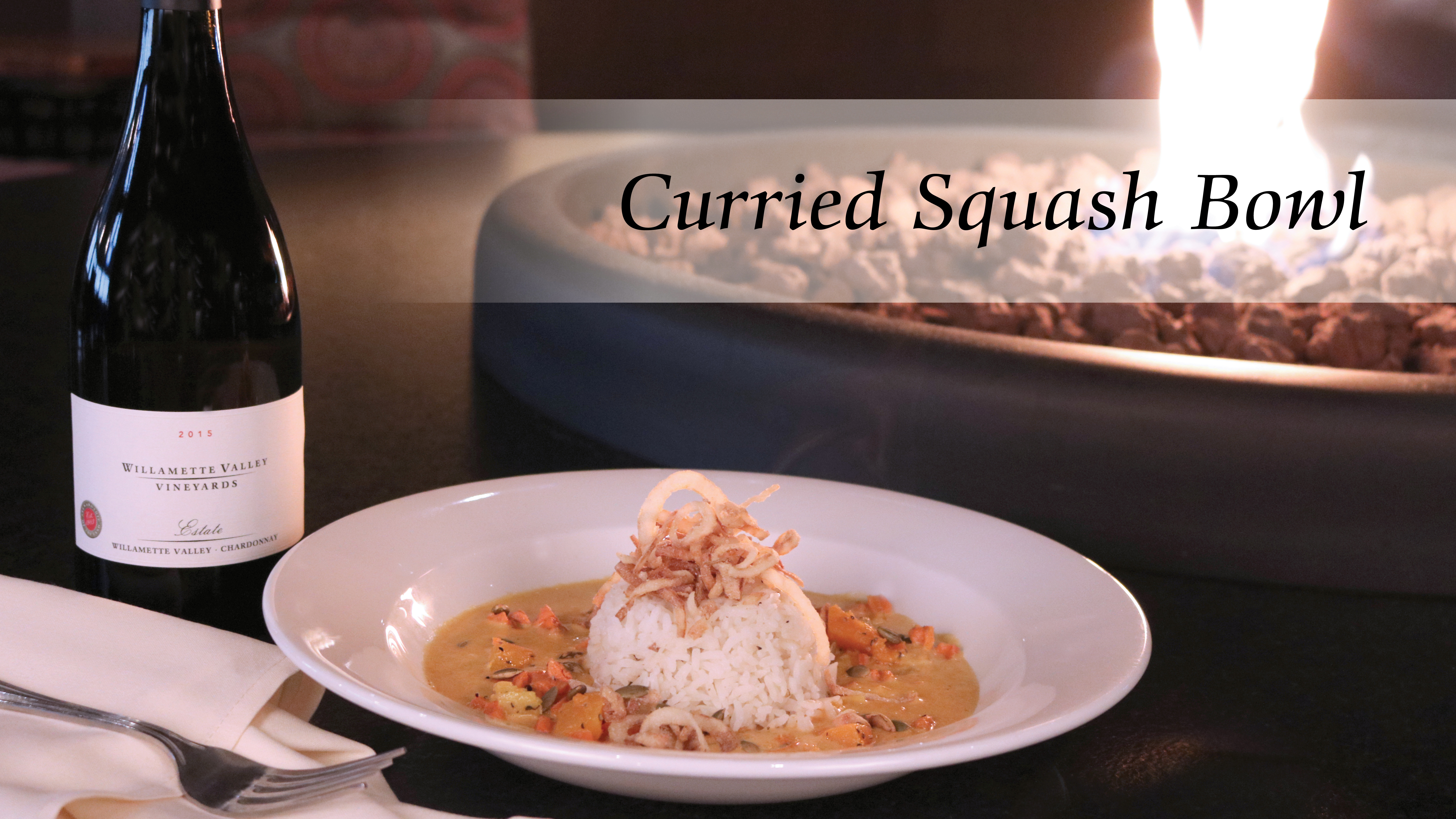
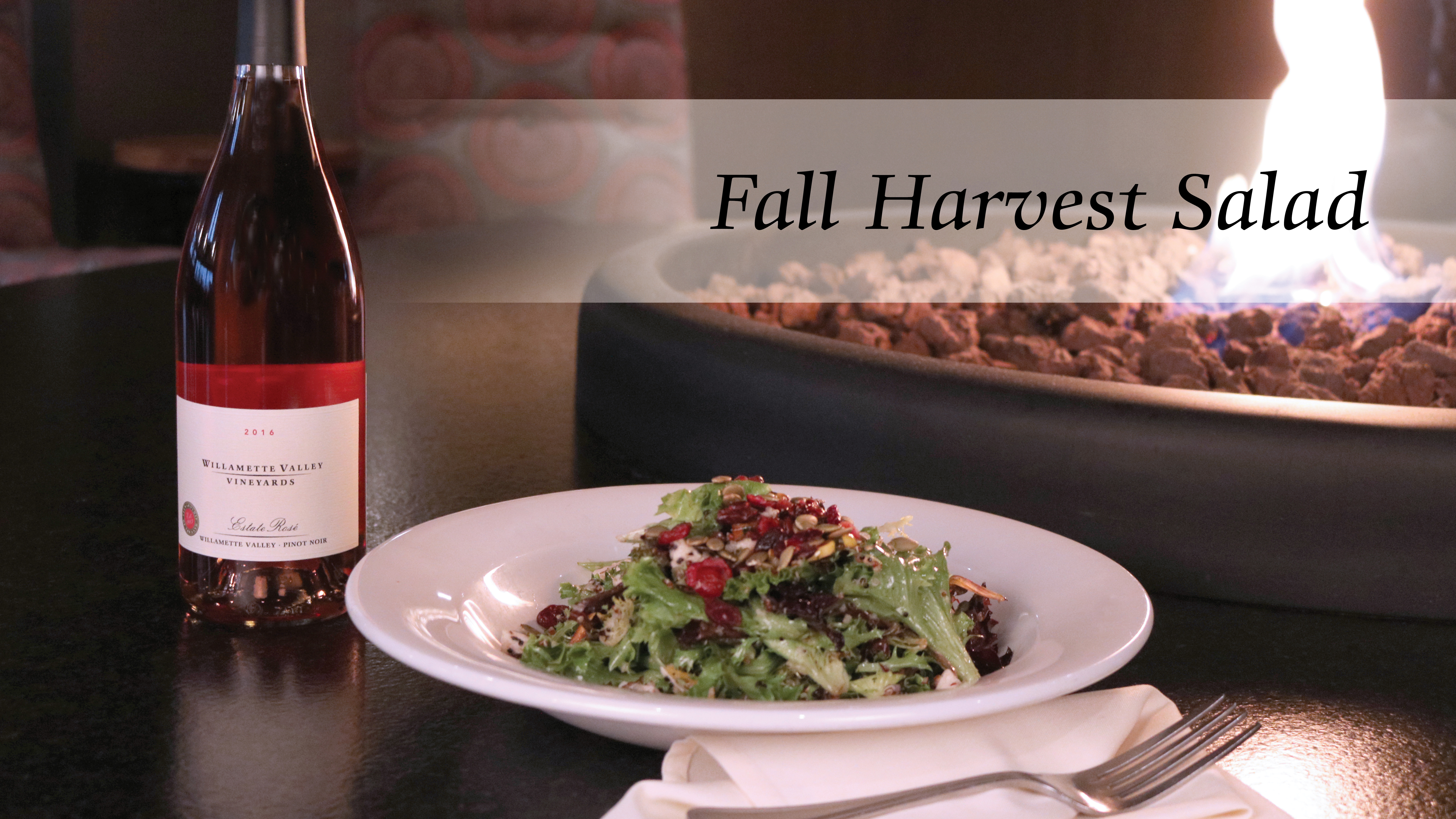
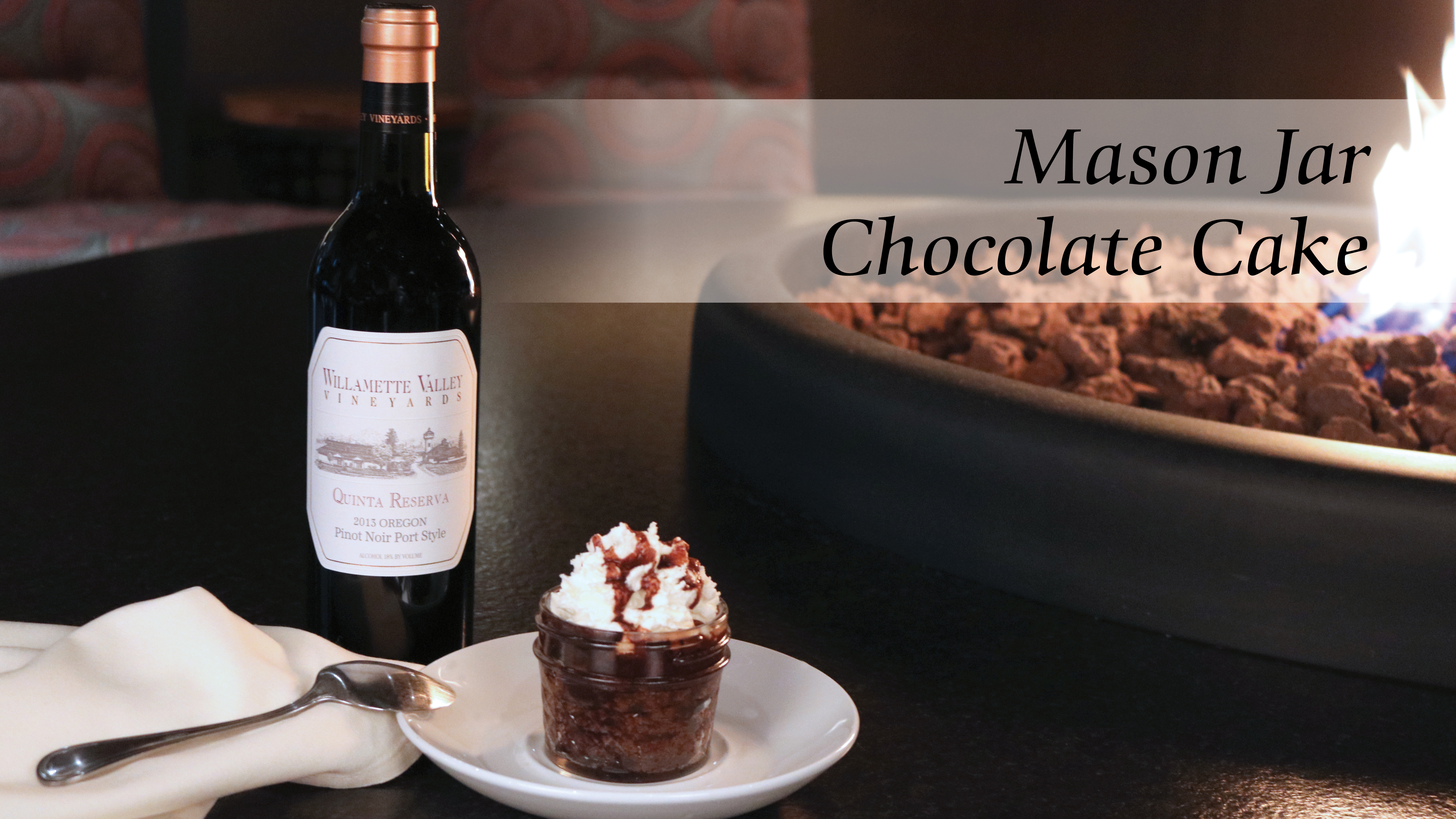
Halloween at the Estate
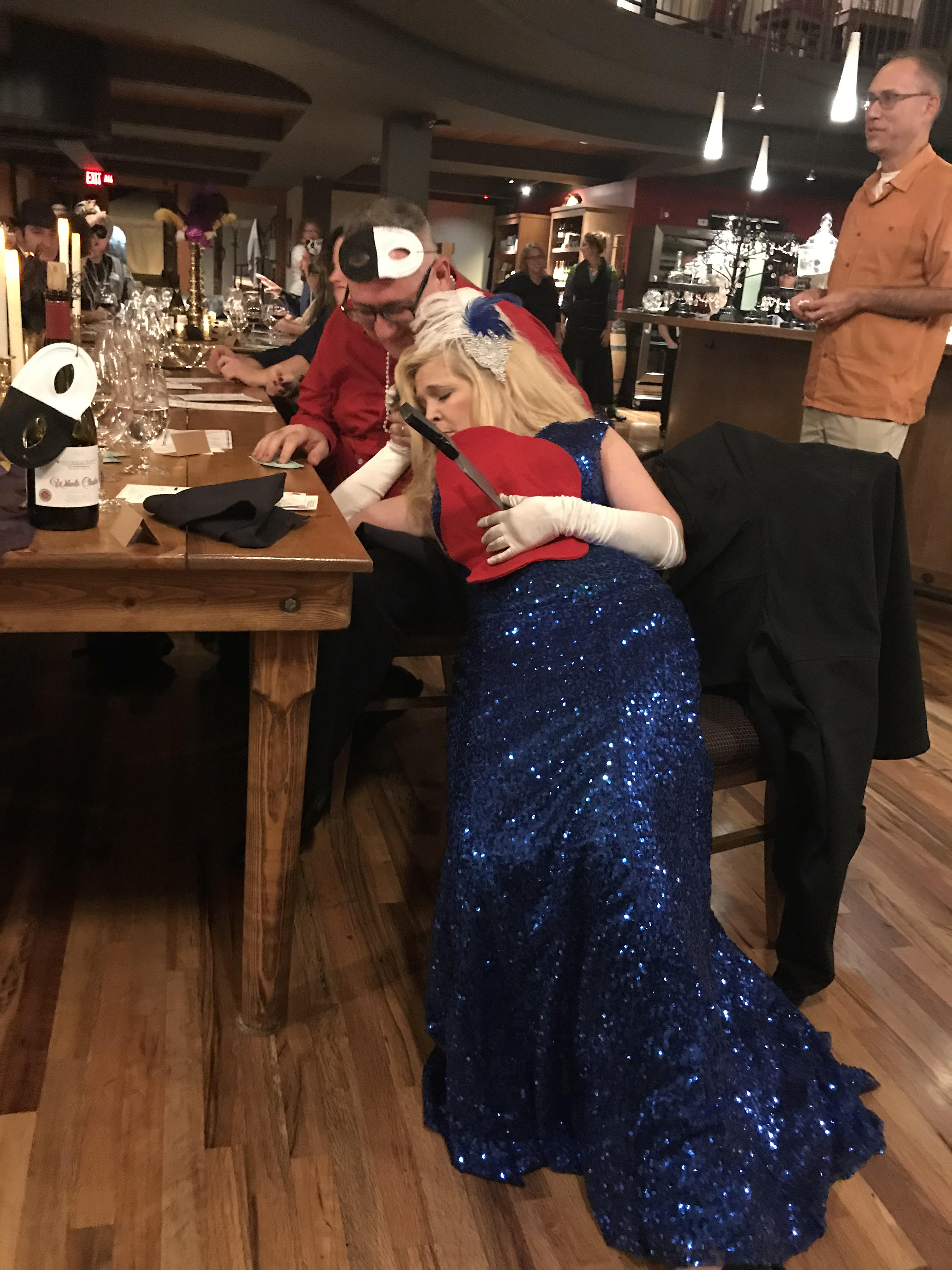
Celebrating Halloween is always a scary good time at our Estate, south of Salem. This weekend we enjoyed hosting many of our Wine Club Members and Owners during our annual Murder Mystery Dinner! This year, our members dared to join us at the Mayor's mansion and enjoyed a custom New Orleans inspired menu created by Winery Chef, DJ MacIntyre paired with our latest wine releases. Little did they know, there would be more than wine pouring during their dinner...but maybe even a little blood.
Today, many team members are enjoying the fun of the holiday and dressing up for our guests who join us for a tasting. Introducing our new Tasting Room Associates: Rosie, John Wayne, Elvira, and Ms. Marilyn Monroe. We look forward to seeing all of our ghoulish guests dressed up and enjoying some of our classic Oregon wines!

